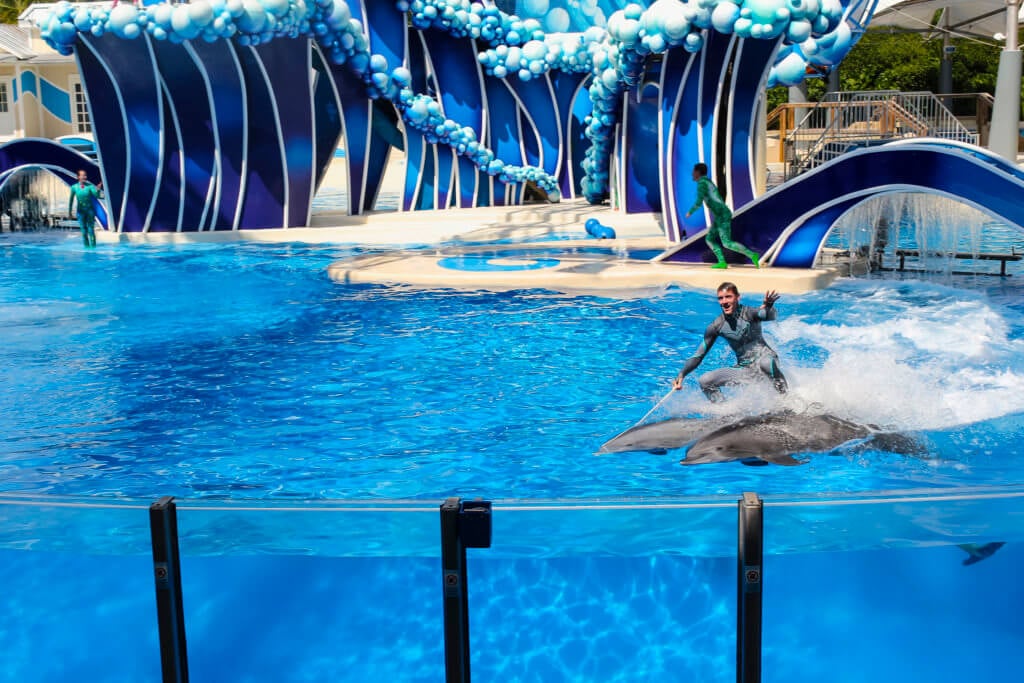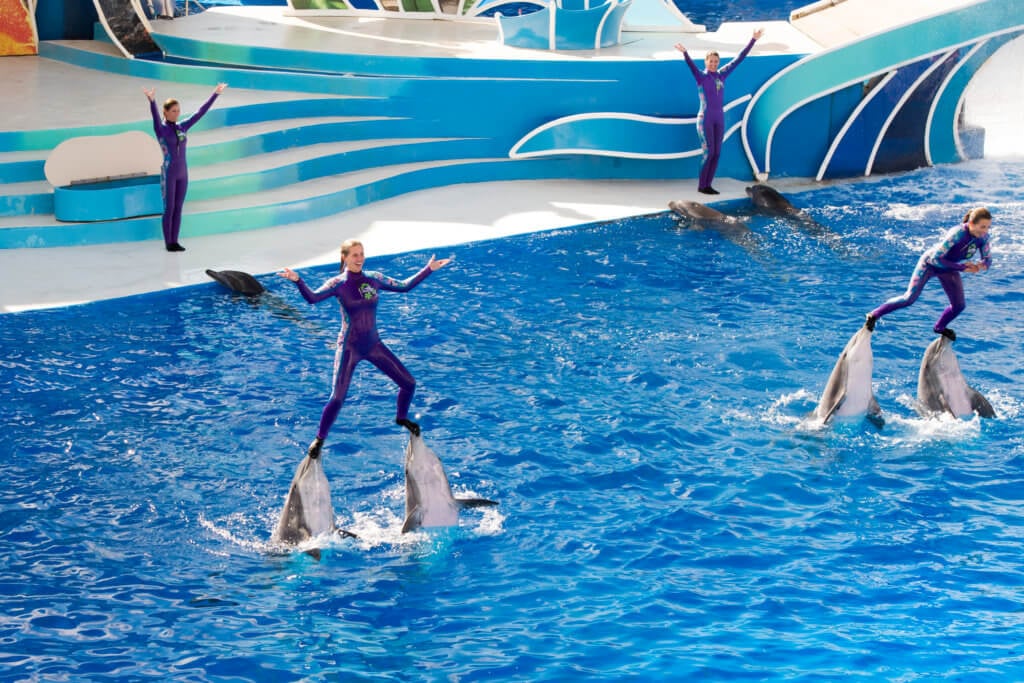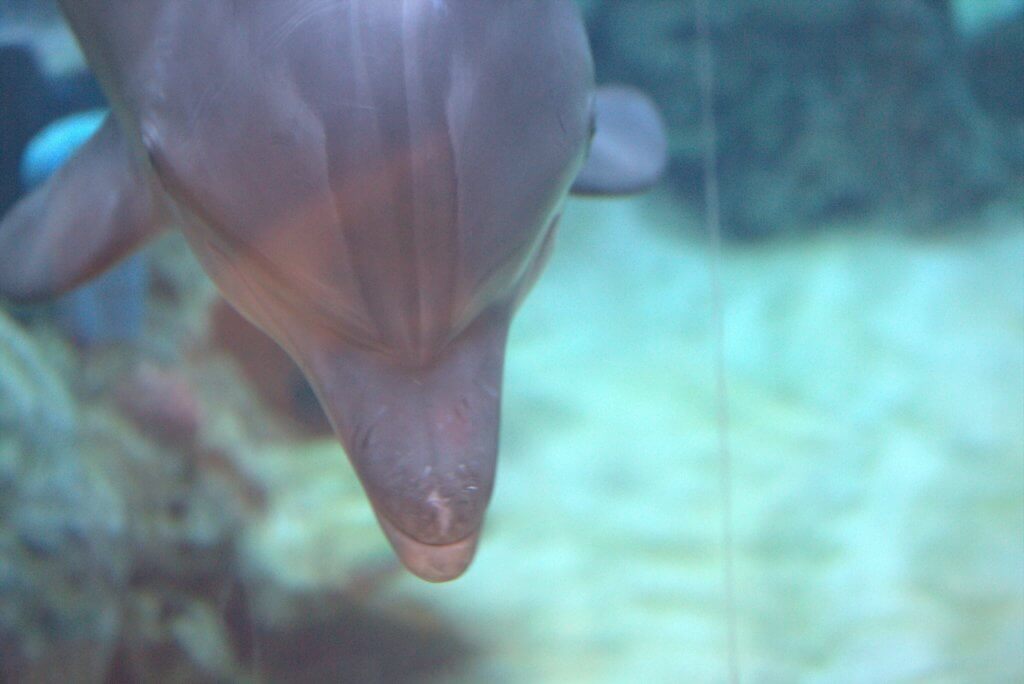PETA Campaign Ends Cruel ‘Dolphin Surfing’ at SeaWorld

Update: February 5, 2020
Victory! SeaWorld has stopped treating dolphins like surfboards and will soon stop making trainers stand on their faces in demeaning circus-style shows.
SeaWorld admitted that it’s ending the cruel practices in response to PETA’s latest shareholder proposal calling for the changes. We also released a damning veterinary report exposing the suffering that dolphins endure at the parks, Alec Baldwin asked a shareholder question during the company’s annual meeting, we launched numerous local ads, and more than 133,000 of our members and supporters took action.
While we’ve stopped trainers from treating dolphins like surfboards and launchpads, orcas and dolphins continue to suffer in tiny concrete tanks. Please join PETA in demanding SeaWorld put a plan in place to move the animals to seaside sanctuaries now.
Originally posted on June 5, 2019:
While SeaWorld has ended its orca-breeding program and will phase out orcas at its abusement parks, a PETA veterinarian reveals the suffering that other dolphins endure at SeaWorld and issues a new call to action: Stop trainers from abusing dolphins by riding on their backs and standing on their faces.
With its eye on the bottom line, SeaWorld continues to breed and exploit bottlenose and Pacific white-sided dolphins while ignoring their natural needs. Trainers use the dolphins as surfboards, riding on their backs and standing on their faces in cruel and demeaning circus-style tricks. After observing captive dolphins at parks in Orlando, San Antonio, and San Diego, veterinarian Dr. Heather Rally and cetacean behavioral biologist Dr. Toni Frohoff concluded that the animals’ well-being is severely compromised by their confinement and use in these stunts and that the physical and social stress that they routinely endure often results in painful injuries.
Deprivation
Whether wild-caught or captive-bred, dolphins are biologically driven to perform highly motivated natural types of behavior that help them thrive in an ocean environment. They swim up to 60 miles a day, dive to depths of nearly 1,500 feet, and maintain dynamic relationships within a large, complex social network.
At SeaWorld, they’re confined to small, shallow, severely crowded concrete tanks that are spatially, acoustically, and visually unnatural for the species. Devoid of natural features, hiding places, or variation, they create an environment of inescapable, routine stress.
Exploitation
Dolphins confined to SeaWorld’s show tanks are forced to perform in exchange for dead fish twice a day before raucous crowds and while being subjected to disorienting, amplified music, a constant aural assault that’s a likely cause of chronic stress.
 ©dreamstime.com/Paul Brewster
©dreamstime.com/Paul BrewsterExploiting them in circus-style performances that are devoid of significance to the animals or educational value for the public—including for stunts in which trainers “surf” on dolphins’ backs or stand on their rostrums (the beaklike projections of their mouths) as they’re propelled through the water—likely exacerbates their suffering.
 ©dreamstime.com/Izanbar
©dreamstime.com/IzanbarCountless dolphins at SeaWorld parks were observed to have open wounds on their rostrums and extensive scarring indicative of pre-existing wounds. Even though it’s common for dolphins confined to restrictive environments to injure their rostrums on the hard surfaces of the enclosures to which they’re confined, SeaWorld still forces them to perform demeaning tricks that can further abrade their skin.

These injuries pose potential health risks to the dolphins, especially to their mandible, the lower jaw that bears nearly all the trainer’s bodyweight when he or she stands on the rostrum. Filled with delicate, fatty tissue that allows the animals to receive underwater sound vibrations through the jaw bone, the mandible is a sensitive structure that’s crucial to dolphins’ hearing.
Exposing its bones and joints to routine, excessive force causes the animals discomfort and may damage their acoustic health.
Suffering
Dolphins are highly intelligent, emotional, self-aware animals. Their social lives include intimate, lifelong relationships and dynamic affiliations among pods, but because SeaWorld houses them in artificial social groups in enclosures just a fraction of the size of their natural home range, they’re acutely susceptible to suffering.
Aggression among captive dolphins is commonplace. Many of those observed at SeaWorld had rake marks and scars from being bitten, which can have serious health implications. The skin is an animal’s first line of immune defense—so not only are extensive or repeated breaks painful, they also expose the tissues and blood vessels under the skin to environmental pathogens, putting them at risk for localized and even systemic infection.
Dental trauma is also common among captive dolphins, who can develop self-injurious behavior patterns that cause damage to their teeth as a result of chronic deprivation or stress. The trauma endured by many of SeaWorld’s captive dolphins was so severe that their teeth were missing above the gum line.
